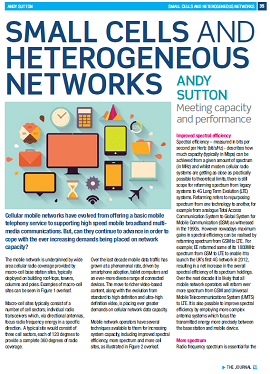Small Cells and Heterogeneous Networks

This paper was published in 2016 within the Journal of the Institute of Telecommunications Professionals (Volume 10, Part 2, Pages 35-39) and is made available here with their kind permission.

Introduction
Cellular mobile networks have evolved from offering a basic mobile telephony service to supporting high speed mobile broadband multimedia communications. But, can they continue to advance in order to cope with the ever increasing demands being placed on network capacity?
The mobile network is underpinned by wide area cellular radio coverage provided by macro-cell base station sites, typically deployed on building roof-tops, towers, columns and poles. Macro-cell sites typically consist of a number of cell sectors; individual radio transceivers which, via directional antennas, focus radio frequency energy in a specific direction. A typical site would consist of three cell sectors, each of 120 degrees to provide a complete 360 degrees of radio coverage.
Over the last decade mobile data traffic has grown at a phenomenal rate, driven by smartphone adoption, tablet computers and an ever-more diverse range of connected devices. The move to richer video-based content, along with the evolution from standard to high definition and ultra-high definition video, is placing ever greater demands on cellular network data capacity. Mobile network operators have several techniques available to them for increasing system capacity, including improved spectral efficiency, more spectrum and more cell sites.


Follow on social media .....